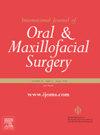使用空心无头螺钉开放治疗髁突头骨折的长期疗效回顾性分析。
IF 2.2
3区 医学
Q2 DENTISTRY, ORAL SURGERY & MEDICINE
International journal of oral and maxillofacial surgery
Pub Date : 2025-02-14
DOI:10.1016/j.ijom.2025.01.018
引用次数: 0
摘要
影响髁突头(CHF)的下颌骨骨折的治疗可采用闭合或开放两种方法。在开放入路的情况下,无头骨螺钉(HBS)是一种选择。本研究通过三维放射成像和长期随访的临床评估来研究HBS骨固定的疗效。这是一项单中心回顾性研究。随访期间收集临床参数和三维x线片,对DICOM数据集进行分割,并进行模型分析。45名接受HBS且符合资格标准的患者被纳入研究。所有临床参数均有显著改善(开口、前突、后突;均P < 0.05),但未患侧突出(P = 0.071)除外。从术后(平均1.9天)到最终随访(平均1675天),平均体积和表面积变化分别为127.2 mm3和-22.4 mm2,差异无统计学意义(P = 0.18和P = 0.51)。有髁重构的影像学征象。9例患者中的9例HBS由于螺钉穿透愈合的髁头关节面而需要取出。这项单中心回顾性研究发现,HBS治疗CHF的功能预后良好,螺钉取出率为20%。本文章由计算机程序翻译,如有差异,请以英文原文为准。
Long-term outcomes of open treatment of condylar head fractures using cannulated headless bone screws—a retrospective analysis
The treatment of mandibular fractures affecting the condylar head (CHF) can be either closed or open. In the case of an open approach, the headless bone screw (HBS) is an option. This study was performed to investigate the efficacy of osteosynthesis with HBS using three-dimensional radiographic imaging and clinical evaluation over long-term follow-up. This was a single-centre retrospective study. Clinical parameters and three-dimensional radiographic scans were collected during follow-up, DICOM datasets were segmented, and model analysis was conducted. Forty-five patients who received a HBS and met the eligibility criteria were included. There were significant improvements in all clinical parameters (mouth opening, protrusion, laterotrusion; all P < 0.05) except for the laterotrusion of the unaffected side (P = 0.071). Mean volume and surface area changes (from postoperative (mean 1.9 days) to final follow-up (mean 1675 days)) were 127.2 mm3 and −22.4 mm2, respectively, and were not statistically significant (P = 0.18 and P = 0.51). There were radiographic signs of condylar remodelling. Nine HBS in nine patients required removal due to the screw penetrating the articular surface of the healing condylar head. This single-centre retrospective study found good functional outcomes using HBS for CHF, with a screw removal rate of 20%.
求助全文
通过发布文献求助,成功后即可免费获取论文全文。
去求助
来源期刊
CiteScore
5.10
自引率
4.20%
发文量
318
审稿时长
78 days
期刊介绍:
The International Journal of Oral & Maxillofacial Surgery is one of the leading journals in oral and maxillofacial surgery in the world. The Journal publishes papers of the highest scientific merit and widest possible scope on work in oral and maxillofacial surgery and supporting specialties.
The Journal is divided into sections, ensuring every aspect of oral and maxillofacial surgery is covered fully through a range of invited review articles, leading clinical and research articles, technical notes, abstracts, case reports and others. The sections include:
• Congenital and craniofacial deformities
• Orthognathic Surgery/Aesthetic facial surgery
• Trauma
• TMJ disorders
• Head and neck oncology
• Reconstructive surgery
• Implantology/Dentoalveolar surgery
• Clinical Pathology
• Oral Medicine
• Research and emerging technologies.

 求助内容:
求助内容: 应助结果提醒方式:
应助结果提醒方式:


